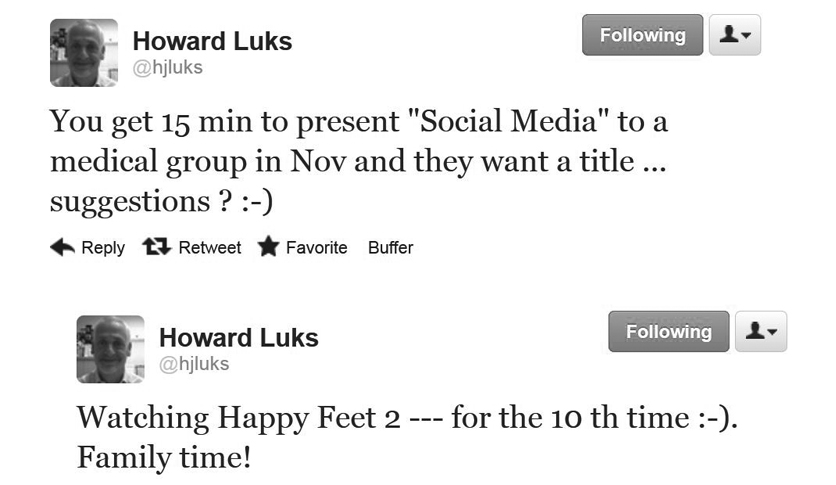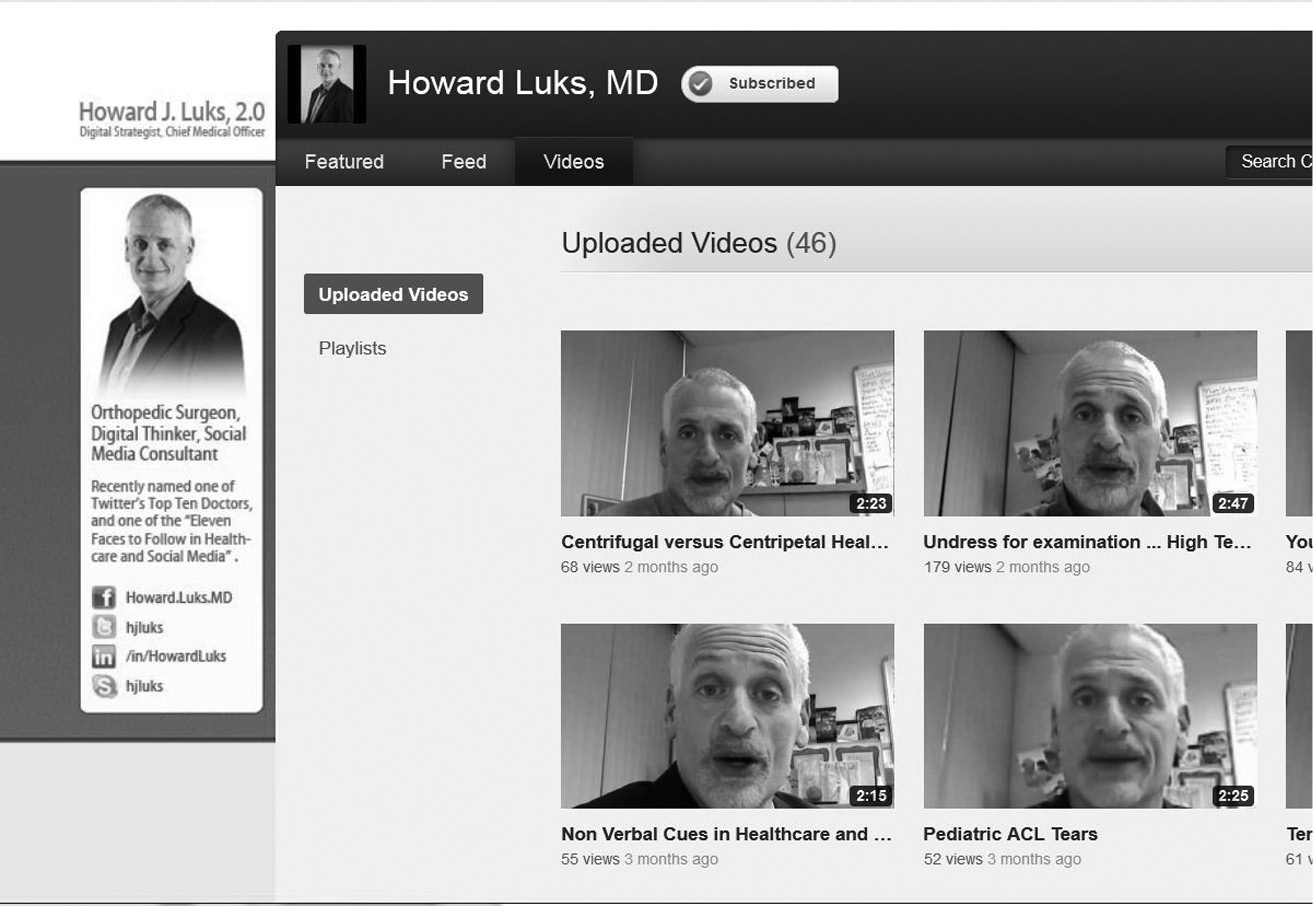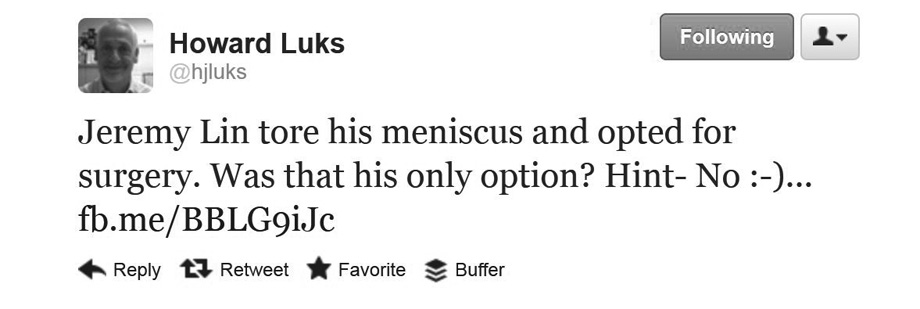Chapter 11
Empowering Health Care
“Sparing people the need for surgery one at a time :–( Need an app for this!!!”
@hjluks

Howard J. Luks, M.D., is far more than just a great physician. Named as one of “Twitter’s Top Ten Doctors,” as well as one of the “Eleven Faces to Follow in Health Care and Social Media” by FierceHealthIT, Howard is testimony to the changing face of health care using social media as a platform to educate and empower his patients.
He’s approachable and likable, and he enjoys lively banter with his followers but beyond that, his personal brand is one of education, reassurance, and empowerment — three things that today’s health care system desperately needs to impart to the wider community.
Howard has managed, through clever and insightful use of his social networks, to blur the somewhat starchy boundaries that have traditionally existed between doctor and patient. His daily tweets (@hjluks) provide the perfect edutainment blend of fact, humor, and reciprocation.
What’s more, Howard knows how to involve his audience on a personal level, using everything from asking for advice on his medical conference speeches to sharing favorite family and leisure time moments (see Figure 11-1).
Figure 11-1
Howard J. Luks, M.D., involves his Twitter audience on a personal as well as professional level.

It’s interesting to note that social media use among physicians is actually higher than among consumers in general, as discovered by a CSC study in 2011. Surprisingly, though, the study went on to report that most physicians are using social media in their personal but not professional lives.
Howard sees this trend as something that needs to change, not only to empower patients but also physicians themselves. He believes, as research supports, that by embracing social media, doctors could reduce their workloads by moving some of the interactions now on the phone or in the office to social media platforms.
He says, “Important changes are taking place that will forever change the way the physicians and patients interact. Shared-decision-making principles, the concept of informed choice versus informed consent and the desires of the participatory medicine movement, will dramatically alter the health care landscape.”
Wen-ying Sylvia Chou, the program director for the National Cancer Institute’s Health Communication and Informatics Research Branch, shares this view, claiming, “The democratization of information through social media is shaping clinical encounters and the patient-provider relationship.” It’s a statement that firmly resonates through the spectrum of social media platforms used by Howard on a daily basis.
Twitter as a Springboard
Twitter plays a key role in Howard’s use of social media. He sees it as very much a springboard to his other platforms such as YouTube, where he hosts a channel providing a wealth of informative videos explaining treatment options and procedures for a variety of orthopedic conditions (see Figure 11-2). It’s this effective use of cross-platform promotion (CPP) that sets Howard apart from many other physicians using social media.
So how did Howard get started on Twitter, and how did he use it to build such a successful personal brand?
Figure 11-2
Many of Howard’s tweets link to his YouTube videos, which cover a variety of patient conditions and concerns.

Starting Out
Howard was an early adopter of Twitter, signing up for his account back in 2008. As not only a tech-savvy physician but also a social person in general, he was both intrigued by the platform’s potential and keen to try new ways to connect with others.
“I was communicating with, learning from, and teaching people I never would have otherwise met from across the globe. As I started to enjoy using Twitter for my own knowledge, curation, or simple after-hours banter, I started to delve into how Twitter could be useful as a means of fostering my relevance and extending my reach beyond the four walls of my practice.”
This need to extend his reach, inspired Howard to begin sharing content on Twitter using cross-platform promotion to incorporate links to his blog, website, YouTube, and other channels (see Figure 11-3).
Figure 11-3
A great example of Howard’s use of CPP on Twitter, where he links to another of his social media platforms to provide additional information

As the platform began to mature, other physicians, patients, and health care professionals started to appear on Twitter, so Howard began to organize live chats around various topics in health care, as shown in Figure 11-4.
Howard recalls first starting these revolutionary collaborations on Twitter: “We studied and discussed the impact of the mobile health initiatives, behavioral modification, improving compliance with post-visit or discharge instructions, and other similar issues.”
Figure 11-4
An example of the revolutionary way Howard began using Twitter for live chats and expert collaboration.

As a result of his endeavors, key innovators and entrepreneurs in the health care sector began to take notice, and gradually Howard’s online interactions evolved into long-term authentic relationships.
Howard Luks’ Golden Rules for Personal Branding Success
Howard describes his personal brand on Twitter as one that is continually evolving: “My goal is to not only educate patients and my fellow colleagues but to assist entrepreneurs seeking to springboard off Twitter to other useful activities to help physicians in their daily practice.”
Howard’s incredible personal branding success stems from his desire to “support the spread of meaningful, trustworthy, evidence based (when available), actionable information, and guidance to patients and consumers from around the world.” He believes that physicians have a moral obligation to provide quality content and “to drown out the commercialized nonsense that exists online today.”
Howard has used Twitter to humanize his practice and extend his outreach far beyond the four walls of his office (see Figure 11-5). This is ultimately his golden rule to personal branding success using Twitter. Others in his field are slowly emulating Howard’s approach, which is no surprise, as he provides an excellent example of how to balance the flow of content and keep your Twitter stream interesting for followers.
Figure 11-5
Howard has dramatically extended his outreach by providing links on Twitter to treatment guidebooks for patients.

Throughout his years on Twitter, Howard has tried many different approaches in content sharing, frequently incorporating personal tidbits to aid in humanizing both his personal brand and his practice, while enabling patients to become comfortable with him and what he has to offer or say before they enter his office.
Howard also shares content on Twitter to assist others in their interactions with their physicians even if they aren’t his patients (see Figure 11-6) — he calls such people “part of a global patient population that has grown tired of the commercialized nonsense that exists in the online world and is instead looking for useful, meaningful and actionable information.”
Figure 11-6
Howard is happy to offer advice even to followers who aren’t his patients.

Ultimately, Howard firmly believes that all physicians on Twitter need to define their own personal goals and personal brand messages. “They need to experiment with what sticks and what simply passes through the stream untouched. Staying focused and staying engaged is the key to a successful Twitter outreach presence.”
Howard believes that, at its heart, Twitter is about people, about relationships, and about communication. For him, it is about fostering his relevance and value as a physician and educator beyond the four walls of his practice. He believes that “establishing a digital footprint, rooted as a social media presence is about educating, engaging, growing your audience, improving outcomes, improving compliance, and potentially improving the bottom line of your practice.”
Howard underlines his personal branding on Twitter with the philosophy that understanding your audience and staying true to the message you are trying to portray is essential. This knowledge then needs to translate itself into effective engagement, which Howard believes above all else is the key to Twitter success. “The worst mistake you can make is to put information or content on Twitter and fail to engage when someone responds.”
Into the Future
Howard’s personal brand was not built overnight, and he views success as something that happens on a long-term basis. He believes that many of the physician dropout rates occur on Twitter because of a lack of immediate return on investment (ROI).
“The most important lesson I have learned over the years is that you need to be honest with yourself and need to prepare before jumping into the social media waters. Building your brand through social media will not happen overnight — you will go through times where you want a short break and time off the grid, but you will pay the price for doing so.”
Howard has found scheduling tools such as Buffer and HootSuite very useful. “They enable me to anticipate times when I may be busy and not able to tend to my various platforms as often as possible. I can then schedule my tweets to provide my personal brand with a permanent online presence.”
Howard acknowledges that social capital and influence can be fleeting. He believes the most important lesson he has learned is to be honest, open, and transparent, letting people know the person behind the Twitter handle: “Let them decide whether or not the information you have to share is useful. Do not force yourself or overly promote yourself or your relative expertise. Instead let the people decide if you are worth following. If your content and your interactions are useful, they will follow you and they will share with their networks.”
Howard is proud of the many memorable experiences that have been enabled by his personal-brand social media presence. He has appeared on national television and has been asked to share his experiences through high-profile speaking engagements. But he is equally proud of the small wins, too: “When you help a person understand that there is a global presence of engaged health care practitioners who are more than willing to help, it is wonderful to witness that lightbulb moment and know that you made a difference in that person’s life or comforted them in their time of need.”
Howard believes that Twitter will continue to evolve as the platform matures and the API is used by the community to build platforms and tools that provide active users an easier and more targeted means of engaging with and helping patients looking for information on their disease process or a quality physician to work with them.
Howard believes his own presence on Twitter will continue to mature as he discovers new ways of interacting with different patient communities, like-minded physicians, and organizations looking for guidance or assistance in navigating the social space (see Figure 11-7).
Figure 11-7
Howard has been instrumental in showing other physicians how to create a personal brand using Twitter; he was recently featured in my interview with the global health care marketing agency FEED.

Howard also hopes that Twitter itself will evolve in a way that provides consumers and the physician community alike with a more useful and strategic means of using the platform for education outreach, learning, and sharing.
Howard successfully puts into practice all the steps to personal branding on Twitter that I cover in Chapter 8 as well as incorporating the four types of tweet that I introduce in Chapter 5. His is a true Twitter success story, and one that we can all learn from and be inspired by.

